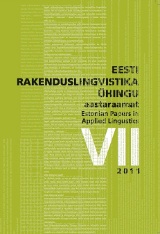Läänemeresoomlaste keele- ja kultuurikontaktidest laensõnade leviku põhjal
On the linguistic and cultural contacts of the Finnic peoples as revealed in the areal distribution of loanwords
Author(s): Vilja OjaSubject(s): Language and Literature Studies
Published by: Eesti Rakenduslingvistika Ühing (ERÜ)
Keywords: Indo-European loanwords; linguistic atlases; linguistic contacts; lexical maps; dialectism; Finnic languages
Summary/Abstract: Two linguistic atlases – the Atlas Linguarum Fennicarum (ALFE) and the Atlas Linguarum Europae (ALE), enable us to follow the post-formational contacts of all Finnic languages. The causes and trajectories of lexical innovation are, in most cases, to be found in extralinguistic factors. New words are usually adopted together with cultural innovations. Close contacts with several Indo-European languages are written into the geographical position of the Finnic languages: East-Slavic languages are spoken in the East, Baltic in the South, Germanic in the North and West. The centres and trajectories of linguistic innovations have a great deal to do with trade. During the Middle Ages the eastern centres of the Hanseatic transit trade between Russia and Western Europe were situated in Estonia and Livonia, and these also became centres of cultural and linguistic innovation. An important trade and communication centre of the Ladogan area was Korela, situated on the Karelian Isthmus. Many Scandinavian loanwords have travelled to Finnish across the Gulf of Bothnia, to spread on along the river Oulu, in some cases up to the southeastern dialects of Finnish.
Journal: Eesti Rakenduslingvistika Ühingu aastaraamat
- Issue Year: 2011
- Issue No: 7
- Page Range: 129-140
- Page Count: 12
- Language: Estonian

